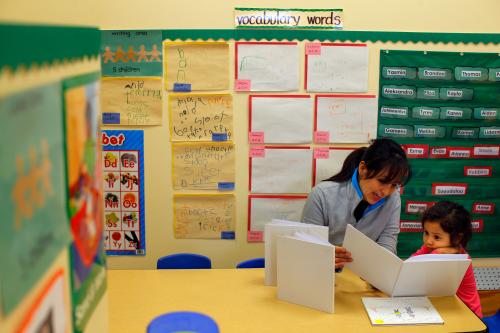The U.S. has a long history of segregation in public education. Though the Supreme Court in Brown v. Board of Education ruled racial segregation in schools unconstitutional more than 65 years ago, nonwhite students are still largely segregated from their white peers. The average Black or Hispanic student attends a school that is less than 30% white, meanwhile the average white student attends a school that is 70% white. This persistent problem will likely be under renewed scrutiny very soon.
The Department of Education under the incoming Biden administration is expected to quickly turn the page on former Secretary Betsy DeVos’s priorities. This expected pivot entails a restoration of Obama-era priorities promoted by former Secretary John King for further racial and economic integration in public schools, among both students and staff.
Typically, research on racial segregation explores the extent to which Black and/or Hispanic students attend racially or economically segregated schools, but the extent of segregation among other student subgroups is less well known. Yet, we see this policy pivot as an opportunity to start considering other ways in which our schools may be segregated.
Specifically, little attention has been paid to the allocation of English Learners (EL), the fastest-growing group in the U.S. student body, who make up 10% of all students and about 20% of nonwhite students. In this piece, we explore the economic segregation of EL students nationwide and its relationship with EL students’ academic outcomes.
Economic segregation of English Learners
Students arriving at public schools who are not fluent in English are considered English Learners. This is a diverse subgroup of students. Some are immigrants to America, but more commonly they are the second-generation children of immigrants to the U.S. About three-quarters of EL students are native Spanish speakers, and the remainder are native speakers of one or more other languages. Most ELs are in elementary grades—they are no longer considered ELs as they gain proficiency in English over time—and attend schools in urban or suburban areas.
Our focus here, though, is not who ELs are but where they attend school. EL students can be found just about anywhere: 81% of U.S. public schools serve at least one EL student. Most ELs, however, are highly concentrated in a small minority of schools, according to our calculations: Approximately 20% of schools enroll 75% of the nation’s ELs. Given the disadvantaged family backgrounds of many ELs—37% of whom live in poverty and 54% of whom have non-college-educated parents, compared to 21% and 37%, respectively, for all public school students—it is perhaps not surprising that schools serving many EL students are commonly high-poverty schools.
ELs’ overrepresentation in high-poverty schools is worrisome. Consider that from the literature on racial segregation, the most detrimental impact on student outcomes is not from Black or Latino students’ low exposure to white students per se, but from the fact that racial segregation happens to result in attending schools with high shares of low-income students. It’s the differential exposure to concentrated poverty, according to recent results from Stanford professor Sean Reardon, that drives racial achievement gaps to widen. This result motivates our inquiry into how ELs may likewise be socio-economically segregated and academically suffer as a result.
Using the most recent data from the Civil Rights Data Collection, we calculate the extent to which EL students are disproportionally represented in low-income schools. To do this, we use the exposure index, which in this case is defined as the average composition of a school attended by a typical EL student. We limit the sample to counties in which EL students make up at least 6% of the student body. Figure 1 shows EL students are more likely to have a greater percentage of low-income student peers than nonwhite students in the same counties who are not ELs, and the percentage for both groups is far higher than that of white students.
To further illustrate the level of economic segregation among EL students in comparison to their nonwhite counterparts who speak English proficiently, we compare the distributions of these two groups of students across school poverty levels. Schools in counties with at least 6% of EL student enrollment were divided into deciles (10 equally sized groups) according to the percentage of students eligible for free or reduced-price lunch enrolled, our proxy measure for poverty. Next, we calculated the share of total students classified as EL and the share of total nonwhite students served in each school poverty decile.
Figure 2 shows the distributions of both student groups across school poverty deciles. If both student groups were equally distributed across schools, then the height of each bar will be equal to 10 percent. Consistent with documented patterns of racial and economic segregation described above, Figure 2 shows unequal distributions, with schools in the higher-poverty deciles serving most EL and nonwhite students.
The surprise here, though, is that EL students display a stronger sorting pattern across school poverty levels than nonwhite students in these same districts. The differences across the two ends of the distribution are striking: Just 12% of EL students attend schools in the three lowest school-poverty deciles, and almost half of ELs attend schools in the three highest school-poverty deciles.
Segregation and EL achievement
The sorting of EL students into high-poverty schools likely hinders their academic success. Prior research shows that schools serving high shares of low-income students have fewer resources per student and hire less-effective teachers. Indeed, EL students are struggling in schools. According to the last administration of the NAEP assessment for fourth and eighth graders, students with disabilities are the only student subgroup that scored lower. For example, fourth-grade EL students scored 219 in math on average (and math is clearly the subject that is least dependent on English proficiency). By comparison, low-income students had a 221 average and Hispanic students scored 231. In addition to low math scores, EL high school graduation rates lag behind their English-proficient peers.
These nationwide outcomes can mask achievement trends across school poverty levels. To unpack these relationships, we calculate the percentage of EL students scoring at or above proficiency in Math in 2017 at each decile of FRPL students. We use state assessment scores in mathematics provided by the U.S. Department of Education. To protect student privacy, proficiency rates are reported as a range unless there are more than 300 students in the reporting group. We use the midpoint of that range to calculate the average percentage of EL students scoring at or above proficiency level in math across schools’ poverty level.
Below, we observe that a larger proportion of EL students score proficiently in math in low-poverty schools than in high-poverty schools. Keep in mind this figure does not show a causal relationship—for example, ELs in low-poverty schools may be more likely to have college-educated parents than those in higher-poverty settings. Yet, access to school resources may very likely play an important supporting role in boosting ELs’ performance.
We need to pay attention to English Learners’ economic segregation
Volumes of studies attest to the idea that segregation hurts students’ learning experience. With growing evidence that segregation efforts in the past (e.g., student busing) have largely stalled in recent decades, alternative strategies to address school segregation are increasingly gaining attention among policymakers and school district leaders. Recent efforts to promote school integration, including the House’s Strength in Diversity Act and the national Bridges Collaborative initiative, are necessary steps in the right direction, though we encourage a more comprehensive approach in tackling school segregation—namely, one that also considers the specific needs of EL students.
We should be careful to note that the economic segregation of ELs likely differs from other patterns of racial or socio-economic segregation in important ways. For example, the lack of English proficiency among EL parents makes it difficult for them to help their children with homework assignments or get involved in school activities, factors that are correlated with student achievement. Choosing schools with other EL students could be a strategic preference to facilitate communication and integration in the school community, as they will be more likely to provide bilingual support. Simply promoting EL integration across schools without supplemental bilingual support could, therefore, end up undermining EL students’ progress.
In addition, we need to better understand how best to support ELs throughout their academic careers. We have evidence-based practices for how to best serve students as they develop English proficiency; however, we know less about longer-term trajectories of these students. Once students emerge from EL status, we often lose track of them (from a policy perspective), even though many will likely have ongoing needs for continued support and there is less consensus on best practices at this stage. Further, what school-level segregation looks like among those ever considered ELs is unclear, and whether policy intervention is needed is also unknown. In other words, we encourage policymakers to consider ELs’ economic integration alongside other integration efforts, though we must be careful not to treat all types of segregation as equivalent.
It’s time to take ELs’ needs seriously. President-elect Joe Biden promised on the campaign trail to “reinstate Department of Education guidance that supported schools in legally pursuing desegregation strategies” and provide grants to school districts for making this a priority. Further, Vice President-elect Kamala Harris has a personal and public history of advocating for the integration of public schools. Now with Biden naming Miguel Cardona as his choice for Education Secretary, who started kindergarten as an English Learner, we hope ELs can get the attention and access to quality education they all deserve.
The Brookings Institution is committed to quality, independence, and impact.
We are supported by a diverse array of funders. In line with our values and policies, each Brookings publication represents the sole views of its author(s).











